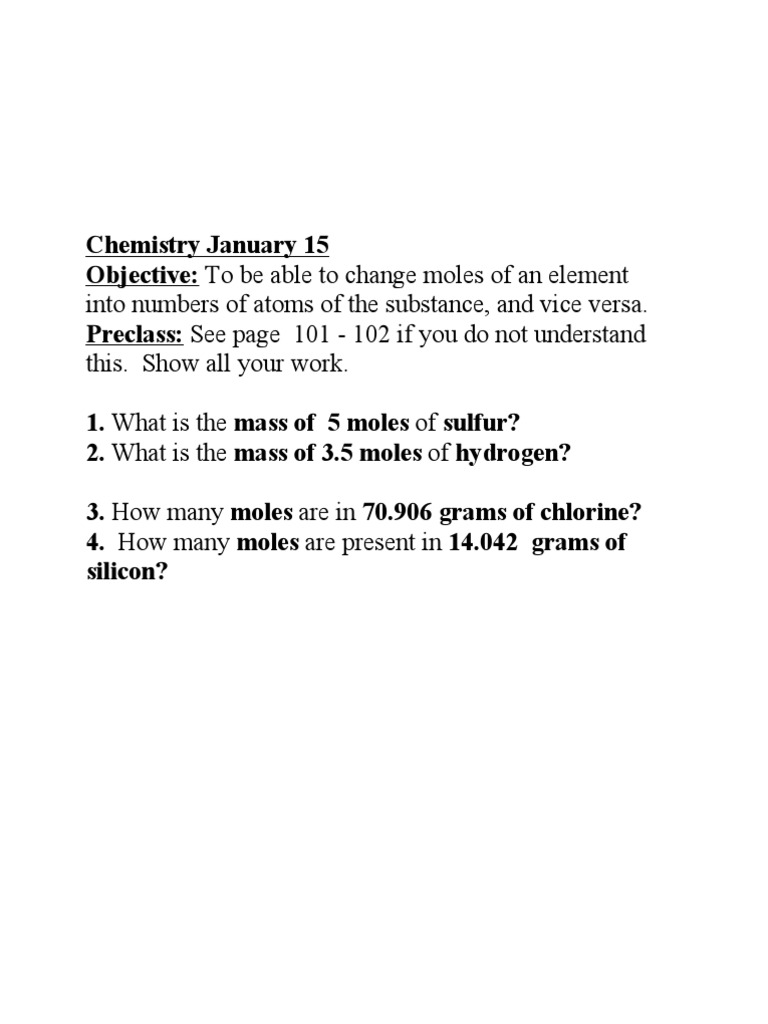Understanding the relationship between atoms, molecules, and moles is essential in the field of chemistry. This understanding not only enriches scientific literacy but also ignites a profound fascination with the microscopic world that underpins all matter. At the heart of stoichiometry, the conversion between these entities is a fundamental concept that resonates across numerous applications, from mundane laboratory practices to cutting-edge research. This essay will elucidate the methodology for performing these conversions, while also exploring the underlying principles that make these interrelations intellectually captivating.
The atom, the fundamental building block of matter, is an entity consisting of protons, neutrons, and electrons. Molecules, on the other hand, are comprised of two or more atoms bonded together, exemplifying the intriguing interactions between different elements. The mole is a unit of measurement in chemistry defined to quantify a vast number of very small entities, similar to how a dozen quantifies twelve items. Specifically, a mole contains Avogadro’s number of entities—approximately 6.022 × 1023. This numerical concept allows scientists to translate macroscopic quantities of substances into the microscopic realm of atoms and molecules.
The process of converting between these units fundamentally relies on a few critical equations and relationships. To transition from atoms to moles, one can utilize the relationship represented by Avogadro’s number. For instance, if one knows the number of atoms present in a sample, dividing this number by 6.022 × 1023 yields the number of moles:
Number of moles = Number of atoms / Avogadro’s number
This operation not only serves as a calculative endeavor but also sheds light on the vastness of atomic quantities, eliciting awe as one contemplates the sheer number of atoms contained within even the smallest everyday objects.
Conversely, when converting moles to atoms, the equation is inverted, emphasizing the direct relationship between these two measurements. Multiplying the number of moles by Avogadro’s number provides a clear pathway:
Number of atoms = Number of moles × Avogadro’s number
This simplicity belies the complexities of atomic interactions, where the behavior of individual constituents informs the properties of entire substances, thus bridging the gap between a theoretical framework and tangible phenomena.
Furthermore, the conversion between molecules and moles parallels the methodology observed in atomic conversions. One molecule constitutes a collection of atoms, and thus, understanding the molecular makeup of a substance is paramount for accurate measurement. The number of molecules in a sample can be calculated using the molar mass—a property defined as the mass of one mole of a substance. The formula for converting between moles and molecules is as follows:
Number of molecules = Number of moles × Avogadro’s number
Again, the reverse operation facilitates the transformation back into moles:
Number of moles = Number of molecules / Avogadro’s number
The beauty of these conversions extends beyond mere calculation; they encapsulate a narrative of scale, allowing us to navigate from the infinitesimally small to the tangible quantities we encounter in daily life. Take, for example, a seemingly simple substance such as water. One molecule of water (H2O) consists of two hydrogen atoms and one oxygen atom. This molecular specificity allows chemists to precisely determine the number of water molecules in a glass based on its volume, establishing a foundational link between abstract chemistry and everyday experiences.
It is also crucial to incorporate molarity and molecular weight into these discussions, as they are pivotal in many practical chemical applications, particularly in solutions. Molarity, defined as moles of solute per liter of solution, offers a direct way to connect moles of a solute to the volume of solution. The ability to concoct specific chemical reactions relies heavily on these calculations, where precise measures ensure desired outcomes. Consider the following formula:
Molarity (M) = Number of moles of solute / Volume of solution in liters
By manipulating this equation, one might derive the number of moles required to achieve a particular concentration, further illustrating the interconnectedness of these different units.
In laboratory contexts, where precision is paramount, a solid grasp of these conversion techniques can facilitate experiments that explore the nuances of chemical reactions and material properties. Additionally, understanding these principles can evoke a sense of wonder towards the intricate workings of nature itself, where interactions at the atomic level culminate in the myriad of substances that compose our universe.
As we delve into the world of chemistry, the ability to convert between atoms, molecules, and moles serves as both a practical skill and a profound reminder of our connection to the fundamental constituents of matter. It invites us to appreciate the subtleties of the empirical world, engaging with the minute details that construct the macroscopic phenomena we observe. Thus, the exploration of these conversions is not merely an academic exercise, but rather an entry point to deeper inquiries into the nature of existence, making the seemingly mundane act of counting particles a gateway to the awe-inspiring complexities of the universe.












